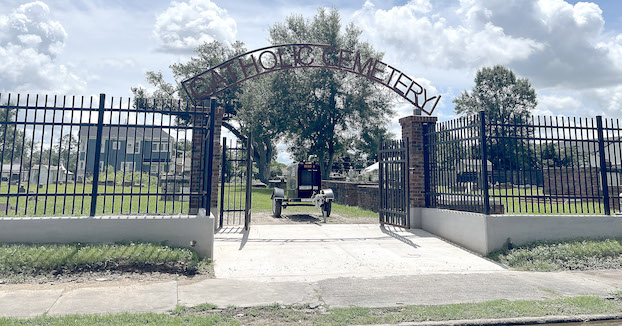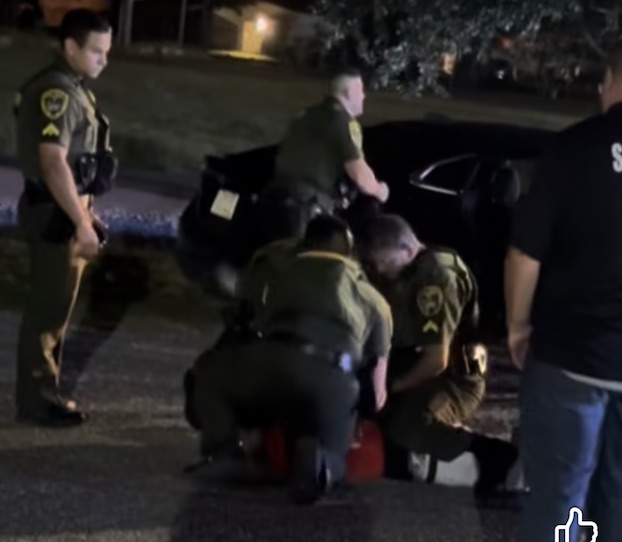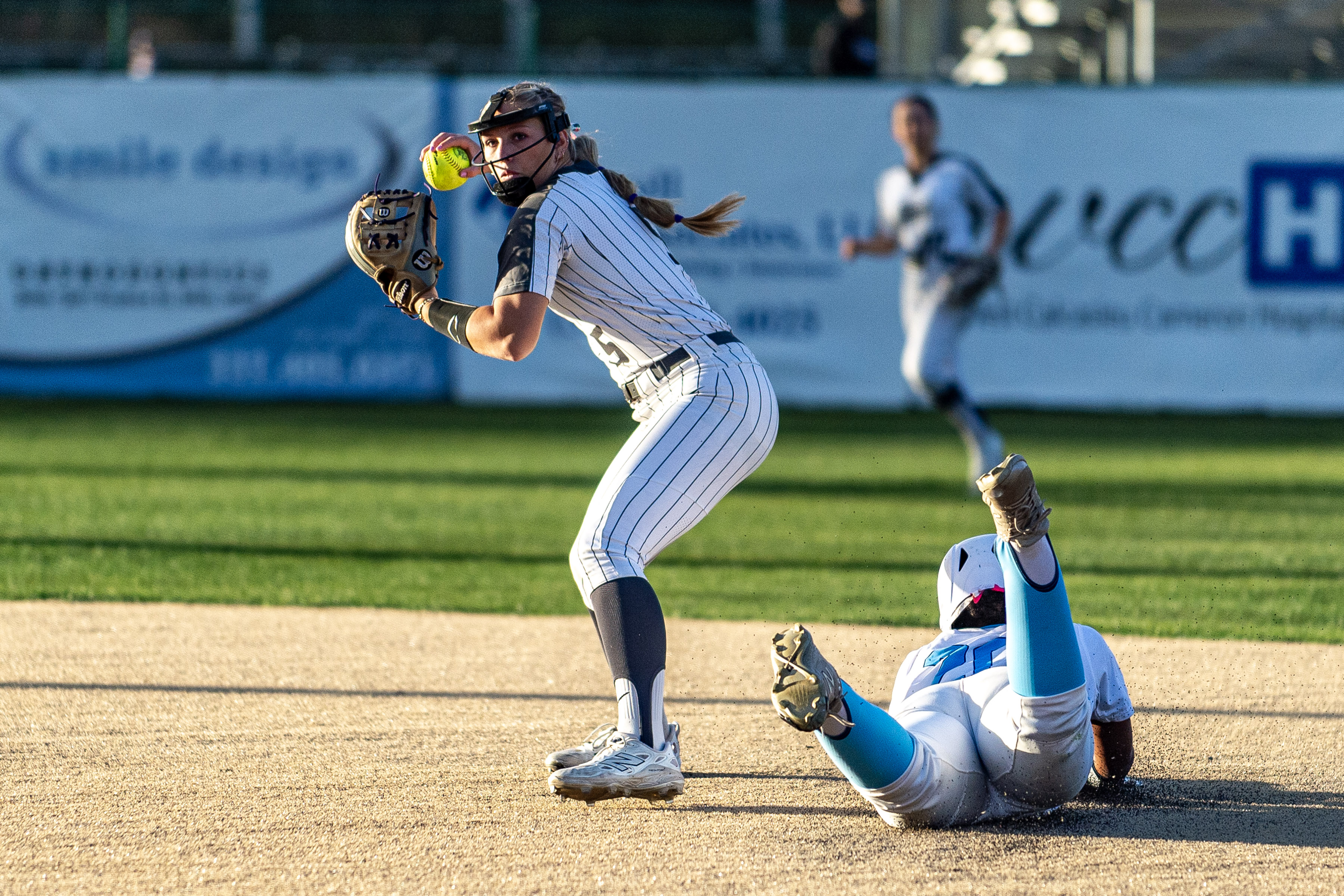Changing landscape: Catholic Cemetery has new look as improvements continue
Published 6:06 am Sunday, June 29, 2025

- Repurposed fencing has been erected around Catholic Cemetery in a cement foundation with the capability of removing the panels if need arises. The central gate with brick columns and metal arch sign have also been completed. (Crystal Stevenson / American Press)
By Vincent Lupo
The old Catholic Cemetery at the corner of Common and Iris streets has a “nice” new look thanks in part to an old fence in a very new location.
By divine providence and some curious coincidences, the black aluminum fencing that formally surrounded the housing project at the corner of Lake and 18th streets now encircles the cemetery, which is owned by the Cathedral of the Immaculate Conception. How all of this came about is described below.
In the middle part of November of 2024, my dear friend Jimmy Bushnell mentioned to me that there was an aluminum fence around the Lloyd Oaks Dixie Drive Housing Project that was being demolished for the construction of new housing at that location. He wondered what would happen to that fence and if it could be salvaged for re-use at the Catholic Cemetery.
Later that week, while driving by the demolition site on Lake Street, I noticed the contractor for the preliminary work at the new Mid-City Lofts project was Alfred Palma Construction. The Palmas have been friends of my family for many years. My wife, Paulette, through her former employment (she is now retired) with the city of Lake Charles Permit, Inspection and Planning departments, has worked with three generations of Palmas — Alfred; his son, James; and James’ son, Michael. James’ wife is also distantly related to me.
I immediately phoned my wife and asked her to contact James Palma about the fate of the fence and explain to James why the Cathedral was interested. James, part of a family that has always been extremely charitable both to its own Catholic parish (Our Lady Queen of Heaven) as well as the city itself, was agreeable to donating the fence to the cemetery project — with one caveat. The fencing had to be removed by the Cathedral within a 20-day window so as not to delay the demotion work.
After contacting Cathedral receptionist Sue Burke and reviewing information provided by her, I reached out to Richard Moreno. In an unpublished draft article on the history of the cemetery Moreno wrote, “In 1997, Patrick Webb, Margaret Schmitt and Roland Bodin, a group of persons interested in preserving and restoring the cemetery to the extent possible, formed Catholic Cemetery Restoration Project, Inc. (CCRP), a non-profit 501(c)(3) corporation seeking to plan for restoration of the cemetery.”
The initial directors were Roland Bodin, Jack Brooks, Mary Louise Elms, Zeb Johnson, Taylor Kaough, Sallye LeBleu, Dorothy Plauche, Margaret (Peggy) Schmitt and Patrick Webb. The directors as of 2025 are Sue Burke, Jude Hilliard, Lauren Harrell, Shane Hinch, Aric Pohorelsky, Jared Watson and Moreno who serves as its present chairman.
Moreno’s unpublished article states the cemetery was opened after land was donated for that purpose in 1861. “Since its closure to new burials in 1915, the cemetery condition deteriorated due to passage of time, effects of weather, lack of maintenance and occasions of intentional vandalism.”
For seven years the CCRP had been considering how to raise funds for a plan proposed by former cathedral pastor the Rev. Rommel Tolentino. Father Tolentino had a vision for the cemetery, which was captured in architectural renderings created by local architect Jeff Kudla.
The plans included fencing around the cemetery site to replace the chain-link fence taken down during recent natural disasters as well as an entrance gate, an altar for Masses and a brick memorial wall to honor those persons who are buried in the cemetery but whose grave markers are missing. Work on those plans habitually stalled due to financial constraints. The committee was, however, successful in obtaining a $200,000 NGO grant from the Louisiana Legislature through the 2020 efforts of Rep. Troy Romero and Sen. Jeremy Stine
The grant was obtained and placed in an escrow account. Deadline for use of the funds was June 30, 2025. If not used by that date, the money would have to be returned. However, costs continued to rise. In a 2024 email to the state treasury office seeking guidance about changing the scope of the cemetery project or the proper procedure for returning the funds, the CCRP said “Despite best efforts of our Architect (Kudla) the cost escalation of the contemplated project has continually exceeded funds on hand. As a result, the project as designed is no longer considered feasible with funds on hand in the corporation and the NGO (state grant) funds.”
Later, however, with the sudden, unexpected contribution of the fence materials, the CCRP emailed Kudla, “That fence donation is making it possible to go forward with the project now. That would eliminate cost of new fencing from (the) bid but add the removal costs. There could be enough fence for the entire cemetery perimeter (a square acre — 208.7 feet per side.”)
In his response, Kudla agreed. “Vincent Lupo called me about this. Great idea and opportunity!”
The Kudla plans had already been approved by the Diocesan Building Committee. At the request of present cathedral pastor, the Rev. Ruben Buller, Bishop Glen John Provost approved the fence replacement project if it could be performed solely with the $200,000 state NGO grant. Due to the short deadline to remove the fence and being aware of the extensive work Ribbeck Construction Corporation had performed for the Diocese of Lake Charles — including the restoration of the cathedral in 2019 — the CCRP reached out to Edward “Buzzy” Ribbeck.
Ribbeck’s company almost immediately removed the fence and stored it until preliminary work at the cemetery site was completed. The fencing was then erected in a cement foundation with the capability of removing the panels if need arises. The central gate with brick columns and metal arch sign were also completed. Due again to financial constraints other portions of the project have now been put on hold.
However, according to an email from Ribbeck to Moreno and the CCRP, Ribbeck “would like to complete the south wall, east end foundation and pickets next to the wood fence.”
“When able, I will pay for that by donation from Ribbeck Construction Corporation,” Ribbeck said noting, “I am certain at some point that the neighbor’s wood fence will disintegrate and will not be reinstalled.”
“One of the perplexing long-term issues facing the cemetery,” Moreno said in his unpublished article, “is restoration of the graves. The cost alone for inspecting the graves for condition and to develop plans for restoration using period material is substantial. There is the added complication of trying to identify the current owner of a grave in which burial occurred over a hundred years ago.
“As a related matter,” he added, “graves belong to the family of the person buried therein and not to the (Cathedral) parish. Furthermore, state law requires the permission of the owner of an individual grave if a non-owner desires to perform work on an individual grave. The passage of time since the last burial in the 1910s means that any one grave will have multiple generations of family owners. As a result, the (Cathedral) parish has no right to perform any work on any graves even if it had funds. The (Cathedral) parish only owns the land. There is no easy solution to this problem in the foreseeable future barring substantial donations.”
Although the entire dream project for the cemetery has not become a reality, a good portion has been completed. And that would not have happened without a chance conversation, a few phone calls, some altruistic individuals and God’s hand in all of this.
Like Ribbeck said in another email to Moreno, “It really looks nice, and my crew said people are always stopping by making very nice comments on how nice it looks.”





